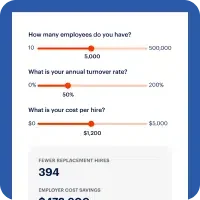Employee churn is the best way to describe both employee turnover and attrition rates. What differentiates the two types of employee departures, what do they mean for your bottom line, and how can they be controlled?
Employee Attrition Versus Employee Turnover
When considering employee attrition versus turnover, companies often use these terms synonymously, when in fact they mean two different types of employee churn and both have an impact on employee retention.
Both employee attrition and employee turnover decrease the number of employees on staff, but employee attrition is typically voluntary or natural — like retirement or resignation.
Turnover focuses on both voluntary and involuntary departures. While turnover includes employees who leave of their own volition, it also refers to employees who are involuntarily terminated or discharged. With turnover, HR is tasked with replacing employees, whereas spots left open from employee attrition may remain unfilled.
Find out how much your company can save by reducing your turnover rate with this interactive calculator.
The Cost Difference Between Employee Attrition Versus Turnover
Just as the definitions between employee attrition versus turnover are different, the costs associated with them are too.
Employee attrition is often viewed as a way that companies can decrease labor costs. Take for instance more severe forms of attrition—like layoffs—which are often deployed as a labor reduction technique. If an employee leaves naturally, and their spot no longer needs to be filled, organizations can freeze hiring to reduce staffing costs.
There is overlap between the two types of churn though.
Some employee attrition can cost as much as turnover. When a voluntary resignation requires a replacement, it’s not cheap to fill the position. The cost to replace an employee ranges from one-half to two times the employee’s annual salary.1
For organizations above a normal attrition or turnover rate, these expenses may add up drastically.
The Average Employee Attrition Versus Turnover Rates
How do you know if your organization has normal attrition or turnover rates? As of July 2022, the average turnover rate across all industries was 3.9%.2 According to the April 2022 Gartner report, the total annual employee turnover will likely jump 20% compared to pre-pandemic averages.3 Turnover rates can vary depending on industries, see where your company stacks up compared to your industry average.
Three Causes of Preventable Attrition and Turnover
Financial Stress
According to the 2022 PWC Employee Financial Wellness Survey, financially stressed employees are twice as likely to look for a new job.4
A financially stressed employee is likely on the lookout for a better-paying opportunity. Financial stress may be more common than you think, consider these fast facts:
- Ninety percent of Americans say their financial considerations have an impact on their overall stress levels.5
- According to a June 2021 report, 61% of Americans are living paycheck-to-paycheck, including 36% of those making more than $200,000.6
Seventy-five percent of workers surveyed struggled to pay their bills this year due to these recent price surges.7
Lack of Advancement Opportunities
One of the reasons why turnover occurs is due to the lack of professional advancement.8 Does your organization offer upward mobility? Grooming high-potential employees to take on more significant roles within the organization is one strategy for minimizing the cost of attrition and turnover. People will stay with you if they have a chance to grow with your company.
Dissatisfaction With Work-Life Balance
Another reason your employees quit is from poor work/life balance. Inflexibility in the workplace is a significant issue, and one growing even faster in a work environment with young people. With the rise of on-demand job opportunities, there are more ways for workers to choose their schedules and pay rates, which is making the industry a growing competitor to typical 9-5 jobs.
Precursors of Employee Departures
There may be signs that your employees are gearing up to leave you. The 2022 Retention Report by Work Institute analyzed data from over 28,000 departing employees to pinpoint precisely how preventable employee turnover is. Their study revealed that over 69% of the reasons employees leave their jobs are preventable.9 What are the signs?
Lack of Engagement and Productivity
Disengaged employees can be a sign of potential looming turnover. According to a Gallup analysis, companies with higher employee engagement see an 81% reduction in absenteeism, 43% reduction in turnover, 18% increase in productivity and a 23% increase in profitability.10
How to Prevent Attrition and Turnover
Understanding turnover and attrition, and the precursors of departures, helps organizations come up with a game plan to prevent and slow it from occurring.
Perform —and Act— on Exit Interviews
Exit interviews are typically reserved for voluntary separations. They are a way to drill down on why employees left, and how you can prevent turnover in the future. It’s important to ask the right questions to make a useful exit interview. Some great examples are:
- How is your relationship with your manager?
- Were the job functions in line with your pre-hire expectations?
- Did this job align with your personal goals?
- Did we provide the tools you needed for success?
Create a Financial Wellness Program
We already know your employees want to feel financially secure. To address this, many employers have begun to research and implement financial wellness programs to help alleviate the everyday stress associated with money pressures. According to the TIAA 2022 Financial Wellness Survey, 51% of respondents think employers have a responsibility to help employees improve/maintain their financial wellness.11
Employee financial wellness programs are programs that help employees better manage their finances and reduce financial stress. As such, they contribute to a better overall financial well-being for employees.
One of the program elements is on-demand pay. Employees having better access to their earned pay removes the reasons for using costly between-paycheck financing like payday loans which exploit the needs of employees.
2 https://www.bls.gov/news.release/jolts.htm:DailyPay, 2020
4 https://www.pwc.com/us/en/services/consulting/business-transformation/library/employee-financial-wellness-survey.html:DailyPay, 2020
5 https://www.cnbc.com/select/why-americans-are-stressed-about-money/:DailyPay, 2020
6 https://www.cnbc.com/2022/08/01/as-inflation-surges-more-americans-are-living-paycheck-to-paycheck.html:DailyPay, 2020
7 https://www.dailypay.com/resource-center/blog/gas-prices-inflation-impact-employees/:DailyPay, 2020
8 https://fortune.com/2022/07/25/workers-quitting-because-of-lack-of-career-advancement/:DailyPay, 2020
9 https://info.workinstitute.com/hubfs/2022%20Retention%20Report/2022%20Retention%20Report%20-%20Work%20Institute.pdf:DailyPay, 2020
10 https://www.gallup.com/workplace/285674/improve-employee-engagement-workplace.aspx:DailyPay, 2020
11 https://www.tiaa.org/public/pdf/2022_financial_wellness_survey_final_results.pdf:DailyPay, 2020














